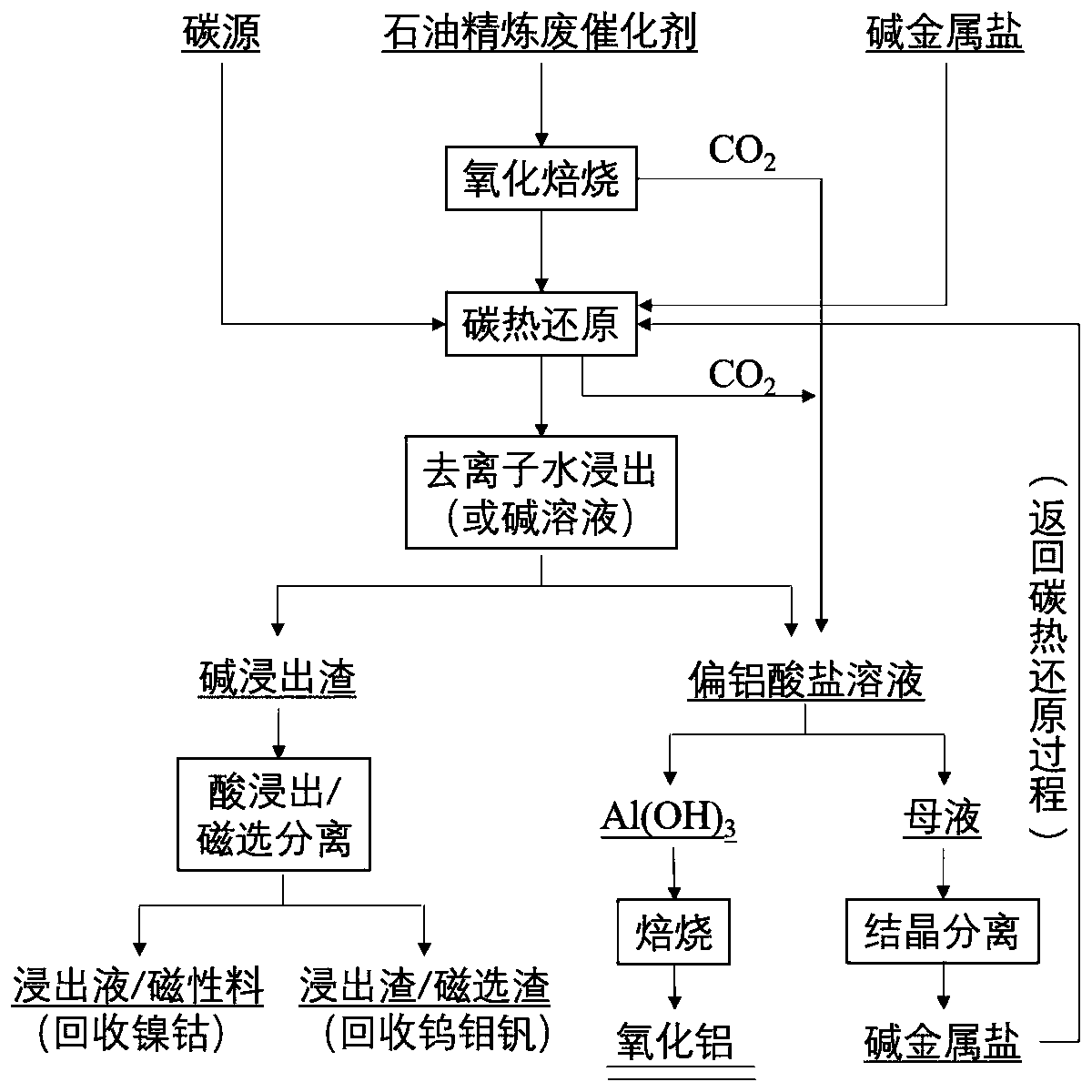A method for recovering valuable elements from aluminum-based petroleum refining spent catalysts
A waste catalyst and petroleum technology, applied in the field of non-ferrous metal metallurgy, can solve the problems of complex separation process and difficult comprehensive recovery, and achieve the effect of simple separation process, significant economic benefits and high economic prospects
- Summary
- Abstract
- Description
- Claims
- Application Information
AI Technical Summary
Problems solved by technology
Method used
Image
Examples
Embodiment 1
[0034] (1) Carbothermal reduction roasting process
[0035] Extraction of spent petroleum hydrodesulfurization catalyst Ni-Mo / γ-Al 2 o 3 , After oxidation and roasting at 550°C, it contains the following elements: Al28.1%, Ni 12.3%, V 6.1%, Mo 4.7%. Add sodium carbonate according to 1.2 times the theoretical demand, then add carbon powder 8 times the theoretical amount, mix and grind until all the abrasives pass through the 200 molybdenum mesh sieve. Place the grinding material in a heating furnace under nitrogen protection, heat it to 950°C at a heating rate of 5°C / min, keep it warm for 180min, then cool it to room temperature and take it out.
[0036] (2) Step-by-step extraction process of valuable elements
[0037] Add the carbothermal reduction product to 2mol / L sodium hydroxide solution, stir and leaching in a water bath at 80°C for 60 minutes, and filter while hot to obtain a sodium aluminate solution. The leaching rate of aluminum exceeds 99%, and metals such as moly...
Embodiment 2
[0039] (1) Carbothermal reduction roasting process
[0040] Extraction of spent petroleum hydrodesulfurization catalyst Ni-Mo / γ-Al 2 o 3 , After oxidation and roasting at 500°C, it contains the following elements: Al28.1%, Ni 12.3%, V 6.1%, Mo 4.7%. Add sodium carbonate according to 2.0 times the theoretical demand, then add graphite powder 5 times the theoretical amount, mix and grind until all the abrasives pass through the 200 molybdenum mesh sieve. Place the grinding material in a heating furnace under nitrogen protection, heat it to 1050°C at a heating rate of 10°C / min, keep it warm for 120min, then cool it to room temperature and take it out.
[0041] (2) Step-by-step extraction process of valuable elements
[0042] Add the carbothermal reduction product into deionized water, stir and leaching in a water bath at 80°C for 120 minutes, and filter while hot to obtain a sodium aluminate solution. The leaching rate of aluminum exceeds 99.6%, and the concentration of metal ...
Embodiment 3
[0044] (1) Carbothermal reduction roasting process
[0045] Extraction of Co-Mo / γ-Al Waste Catalyst for Petroleum Hydrodesulfurization 2 o 3 , After oxidation and roasting at 550°C, it contains the following elements: Al37.9%, Co5.4%, V1.8%, Mo12.7%. Add sodium hydroxide according to 1.5 times of the theoretical demand, then add anthracite coal powder 5 times of the theoretical amount, mix and grind until all the grinding materials pass through the 150 molybdenum mesh sieve. Place the grinding material in a heating furnace under the protection of argon, heat it up to 850°C at a heating rate of 4°C / min, keep it warm for 600min, then cool it to room temperature and take it out.
[0046] (2) Step-by-step extraction process of valuable elements
[0047] Add the carbothermal reduction product to 0.5mol / L sodium hydroxide solution, stir and leaching in a water bath at 80°C for 60 minutes, filter while hot to obtain a sodium aluminate solution, the leaching rate of aluminum reache...
PUM
 Login to View More
Login to View More Abstract
Description
Claims
Application Information
 Login to View More
Login to View More - R&D
- Intellectual Property
- Life Sciences
- Materials
- Tech Scout
- Unparalleled Data Quality
- Higher Quality Content
- 60% Fewer Hallucinations
Browse by: Latest US Patents, China's latest patents, Technical Efficacy Thesaurus, Application Domain, Technology Topic, Popular Technical Reports.
© 2025 PatSnap. All rights reserved.Legal|Privacy policy|Modern Slavery Act Transparency Statement|Sitemap|About US| Contact US: help@patsnap.com

